Abinaya4
On this page, you find all documents, package deals, and flashcards offered by seller abinaya4.
- 7
- 0
- 0
Community
- Followers
- Following
7 items
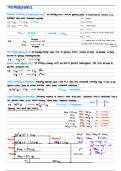
Summary - Unit 3.1.8 - Thermodynamics (A-level only) (Chem)
Thermodynamics in A-Level Chemistry involves the study of energy changes, particularly in chemical reactions. Here's a brief summary of the key concepts: 1. Enthalpy (H) Enthalpy Change (ΔH): The heat energy change measured under constant pressure. Exothermic Reactions: Release heat to the surroundings, ΔH is negative (e.g., combustion). Endothermic Reactions: Absorb heat from the surroundings, ΔH is positive (e.g., photosynthesis). 2. Standard Enthalpy Changes Standard Conditions: 2...
- Summary
- • 6 pages •
Thermodynamics in A-Level Chemistry involves the study of energy changes, particularly in chemical reactions. Here's a brief summary of the key concepts: 1. Enthalpy (H) Enthalpy Change (ΔH): The heat energy change measured under constant pressure. Exothermic Reactions: Release heat to the surroundings, ΔH is negative (e.g., combustion). Endothermic Reactions: Absorb heat from the surroundings, ΔH is positive (e.g., photosynthesis). 2. Standard Enthalpy Changes Standard Conditions: 2...
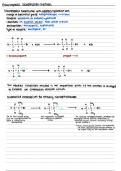
Summary - Organic pathway as (Chem)
Summary - Organic pathway as (Chem)
- Summary
- • 12 pages •
Summary - Organic pathway as (Chem)

Summary - Unit 3.3.6 - Organic analysis (Chem)
Organic analysis in A-Level Chemistry under the AQA specification involves the identification and characterization of organic compounds using a variety of techniques. Here’s a brief summary of the key aspects: 1. Functional Group Analysis Test for Alkenes: Bromine water test. Alkenes decolorize bromine water (from orange to colorless). Test for Alcohols: Primary and Secondary Alcohols: Oxidation with acidified potassium dichromate (orange to green). Tertiary Alcohols: No reaction with a...
- Summary
- • 2 pages •
Organic analysis in A-Level Chemistry under the AQA specification involves the identification and characterization of organic compounds using a variety of techniques. Here’s a brief summary of the key aspects: 1. Functional Group Analysis Test for Alkenes: Bromine water test. Alkenes decolorize bromine water (from orange to colorless). Test for Alcohols: Primary and Secondary Alcohols: Oxidation with acidified potassium dichromate (orange to green). Tertiary Alcohols: No reaction with a...
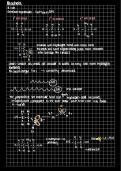
Summary - Unit 3.3.5 - Alcohols (Chem)
Alcohols are a class of organic compounds characterized by the presence of one or more hydroxyl (-OH) groups attached to a carbon atom. Here are the key points about alcohols relevant to A-level chemistry: Structure and Classification General Formula: The general formula for alcohols is C n H 2 n + 1 O H C n H 2n+1 OH. Functional Group: The defining feature of alcohols is the hydroxyl (-OH) group. Classification: Alcohols are classified based on the number of...
- Summary
- • 8 pages •
Alcohols are a class of organic compounds characterized by the presence of one or more hydroxyl (-OH) groups attached to a carbon atom. Here are the key points about alcohols relevant to A-level chemistry: Structure and Classification General Formula: The general formula for alcohols is C n H 2 n + 1 O H C n H 2n+1 OH. Functional Group: The defining feature of alcohols is the hydroxyl (-OH) group. Classification: Alcohols are classified based on the number of...
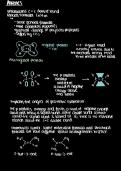
Lecture notes 1.4 alkenes (Chem)
Alkenes are a class of hydrocarbons that contain at least one carbon-carbon double bond (C=C). Here are the key points about alkenes: Structure General Formula: The general formula for alkenes is C n H 2 n C n H 2n , where n n is the number of carbon atoms. Double Bond: The presence of a carbon-carbon double bond defines alkenes. This double bond consists of one sigma (σ) bond and one pi (π) bond. Nomenclature Naming: Alkenes are named by identifying the lo...
- Class notes
- • 8 pages •
Alkenes are a class of hydrocarbons that contain at least one carbon-carbon double bond (C=C). Here are the key points about alkenes: Structure General Formula: The general formula for alkenes is C n H 2 n C n H 2n , where n n is the number of carbon atoms. Double Bond: The presence of a carbon-carbon double bond defines alkenes. This double bond consists of one sigma (σ) bond and one pi (π) bond. Nomenclature Naming: Alkenes are named by identifying the lo...

Lecture notes Unit 3.1.7 - Oxidation, reduction and redox equations
Oxidation, reduction, and redox equations are fundamental concepts in chemistry, particularly in the study of chemical reactions involving electron transfer. Oxidation Definition: Oxidation is the process where an atom, ion, or molecule loses one or more electrons. Oxidation State: The oxidation state (or oxidation number) of the species increases. Example: In the reaction Fe → Fe 2 + + 2 e − Fe→Fe 2+ +2e − , iron (Fe) is oxidized to iron(II) ion (Fe²⁺). Redu...
- Class notes
- • 5 pages •
Oxidation, reduction, and redox equations are fundamental concepts in chemistry, particularly in the study of chemical reactions involving electron transfer. Oxidation Definition: Oxidation is the process where an atom, ion, or molecule loses one or more electrons. Oxidation State: The oxidation state (or oxidation number) of the species increases. Example: In the reaction Fe → Fe 2 + + 2 e − Fe→Fe 2+ +2e − , iron (Fe) is oxidized to iron(II) ion (Fe²⁺). Redu...
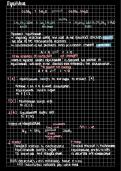
Lecture notes Unit 3.1.6 - Chemical equilibria, Le Chatelier’s principle and Kc (Chemistry)
Chemical equilibrium occurs in a chemical reaction when the rate of the forward reaction equals the rate of the reverse reaction, resulting in no net change in the concentrations of reactants and products. At equilibrium, the system is dynamic, meaning the reactions continue to occur, but the concentrations of the reactants and products remain constant over time. The equilibrium constant, K c K c , is a numerical value that expresses the ratio of the concentrations of products t...
- Class notes
- • 4 pages •
Chemical equilibrium occurs in a chemical reaction when the rate of the forward reaction equals the rate of the reverse reaction, resulting in no net change in the concentrations of reactants and products. At equilibrium, the system is dynamic, meaning the reactions continue to occur, but the concentrations of the reactants and products remain constant over time. The equilibrium constant, K c K c , is a numerical value that expresses the ratio of the concentrations of products t...
